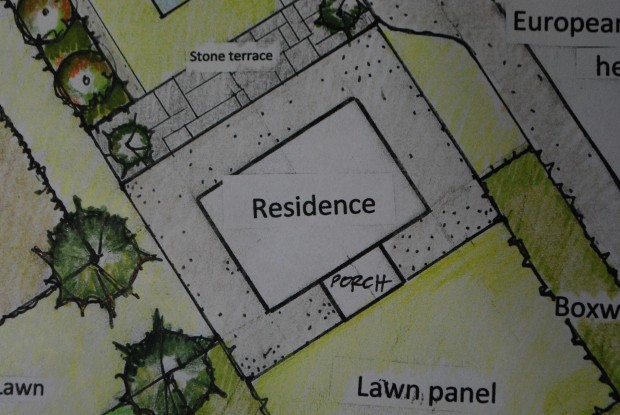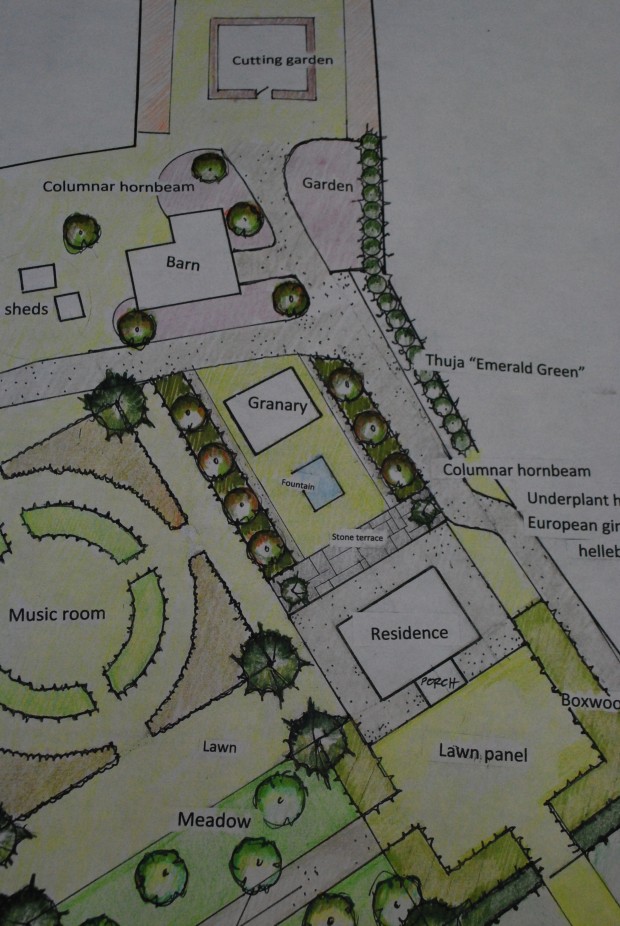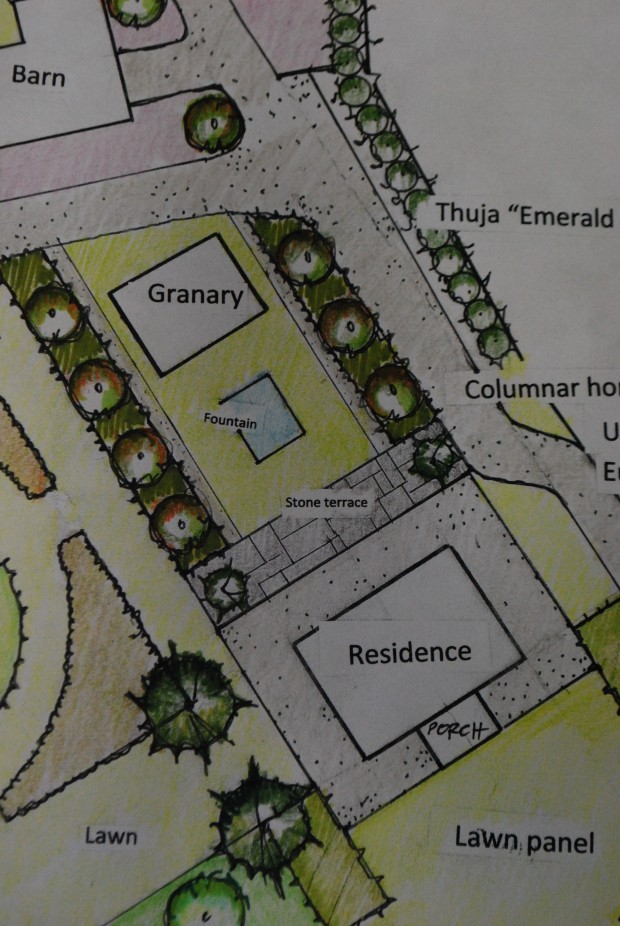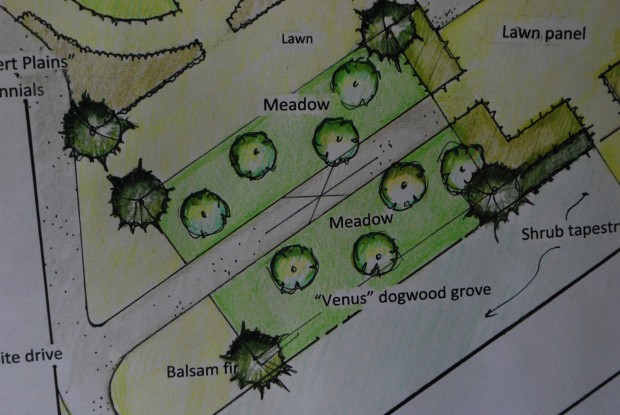What I call a schematic plan is another way of saying master plan. A guide for the development of a landscape. Clients who have an interest in a plan that they can work towards and implement over time always interest me. A landscape of note implies a long term committment-gardeners willing to go that route will not only enjoy the process, but will find so much satisfaction in watching something grow. It takes lots of time to regrade a property, reimagine the space, plant, and arrange for care. This timeline does not even include the plants that die, and the changes that result from experience, or a change in taste. Anyone who buys a ticket for the long term process that a really good landscape requires I admire.
A master plan is a schematic drawing noted for its broad strokes-not its details. The vegetable garden will be there. Friends will park here. Parties could be staged in this garden. Great views of the landscape from inside could be described by this, or that. The rear yard will feature a particular shape-the particular plants are to be determined. How does the landscape address movement? The driveway needs to be this width, and accomodate this turning radius, and needs to gracefully address vehicular traffic. A big scheme is just that-a big fluid wish list with an attempt made to broadly define use and beauty. There will be places to sit, garden spaces-spaces to view from afar. This master plan features a wide swath of decomposed granite all around a 19th century stone farmhouse. There are plans for a conservatory style kitchen across the back of the house. My clients are indicating they want to move ahead with the landscape. This masterplan gives wide berth to additions that are planned for the house. The additions will take vastly less time than the landscape. I advised them that given the length of time it will take to create a landscape, the best time for them to begin construction is right now.
My clients purchased a very large farm- a property that features 2 barns, 2 outbuildings, and a granary. A granary? A beautiful wood structure whose purpose was to store grain is a feature. My plan is to move that granary, currently set above ground on concrete blocks, directly and squarely opposite the rear of their home. The broad gesture? This old stone farmhouse came with the outbuildings that make for a working farm. Though it is unlikely that they will ever grow grain, and have a need to store it, the granary is a great place to stage a summer dinner party. The house and the granary will become substantial bookends for a simple fountain garden.
On either side of that fountain, there is a plan for an allee of columnar hornbeams, underplanted with European ginger and hellebores. It would be a great spot for snowdrops and white crocus-or white Spanish bluebells. This list may change, or be added to, or completely rethought- over time. The hornbeams will be planted equidistant from each other in this garden. Once the allee crosses the gravel drive, the spacing between the trees gets wider, less regular. Though they will be planted in a much less formal area, they will still maintain the site line established by the formal allee.
My clients have a particular interest in music and theatre. They like nothing better than a summer concert staged outdoors. The shape of the gardens adjacent to this round grass space that I call the music room make reference to their neeed for a space for such events. The grasses are an informal material used in a more formal way. The heights of the plants specified will provide some enclosure and privacy. Viewed from the fountain pool, the northern sea oats will provide a contrasting and shimmering backdrop to the more formal and static hornbeam garden. Viewed from the vegetable garden, it will look like a field of grain. A reference to the agricultural history of the property will make those beds more visually believable, given that the setting is rural. But those beds could be a collection of shrubs or small growing evergreens. They could be a perennial mix that peaks during the summer months. They could be planted with roses. A scheme needs to come first. The details can come later.
I have labelled the vegetable garden a potager, as one of my clients is French. The details of this garden will be provded by him. I feel certain it will have a distinctly French feeling. The garden footprint is exactly the size and location of a very old barn original to the farm, which needs to come down. It is deteriorated such that to restore it would take resources my clients prefer to put elsewhere. Hopefully someone will be interested in the salvage of all of the old beams and timbers. The lower portion of the barn walls will be left standing, providing a fence for the garden. Their property is host to lots of wild beings. The floor of the barn has always been dirt. With some work and lots of compost, it will be a great place to grow vegetables.
The other barn is in excellent condition. It holds tools, and soil. In the winter, the boxwoods in pots are stored here. The barn gardens are actually quite beautiful and well developed. There is no need to replace them. The major changes will be about the perimeter shapes of those gardens. A hedge of arborvitae on the lot line will screen the house next door from view. A fenced cutting garden on the dog leg part of the property will be framed by a pair of pumpkin growing gardens. Two gardens devboted to growing pumpkins-how I envy them this.
The gravel driveway design is fairly close to what is existing now. A major change will involve the addition of a drive which goes to the front door. On either side of that drive, a meadow planted with a grove of Venus dogwoods. This meadow is a grass meadow. A low growing low maintenance grass seed will be sown, and cut but once a year. We have had very good luck with this particular seed mix, on unirrigated shady slopes, and in sunnier but relatively infertile ground. The movement of all of the grasses will be a considerable contrast to the primary formality of the landscape.
In the front, the distance between the hedge of Moonii yews and the road is 35 feet, but that footage is a steep slope, culminating in a drainage ditch. The center of this slope will be the same short growing grass as the meadow. This will permit a long view out, to the state lands across the road, from the front porch. Shrubs will be planted into the slope where needed-lilacs, old fashioned spirea, viburnum, sumac, beauty bush-whatever seems right for a free for all mix. Lucky the gardener that has enough land for a free for all.
Of course the first step is to lay out the schematic plan, and see how it looks on the ground, full sized. A lot of the preliminary tree work has already been done. My clients seem to think the schem suits their property, their taste, and the history of the farm. I am so pleased that this project is underway.










I am so pleased this project is beginning. I know the finished project will be outstanding as will the journey in between. Lucky, lucky homeowners. Lucky readers of the Dirt.
love this plan. it rocks! I would be interested in looking at the barn that is about to be salvaged. A potager emerging from the ashes of a 19th century barn? Who knew?
buck
To work at a site such as this must come with a certain amount of awe. Am I right? The history, the stone house (is it fieldstone?), a granary; what a beautiful place now – I can only imagine what is yet to be. Thank you for sharing.
It is a beautiful piece of property, and the buildings are old. My clients love living there. It will be an amazing project to work on.
What a wonderful place and the plan is very exciting. Thank you for sharing this with us!
Deborah this looks awesome! The idea to move the barn and turn it into a “party hut” is awesome. I can imagine parties there especially in fall…with bales of hay etc. This and the potager are my two favorite parts of the plan. Has it been finished yet, because if so, and the owners approve, I’d sure love to see pictures.
This is a very big project, and it will take a long time to get it all together!
I loved reading about this plan. Have your clients made much progress? My husband and I purchased a farmhouse built in 1901 on a half acre city lot in Pittsburgh a year ago. The previous owner had a landscaper draw up a plan but it was never implemented. I have tracing paper over it and am trying to figure out the master plan now. I plan to do most of the work myself so it will be a long process for me too.
I discovered your blog yesterday and have been reading all of your landscape designs posts. Do you have any landscape designs books that you would recommend to me? Thank you for sharing your insights here, they are much appreciated!